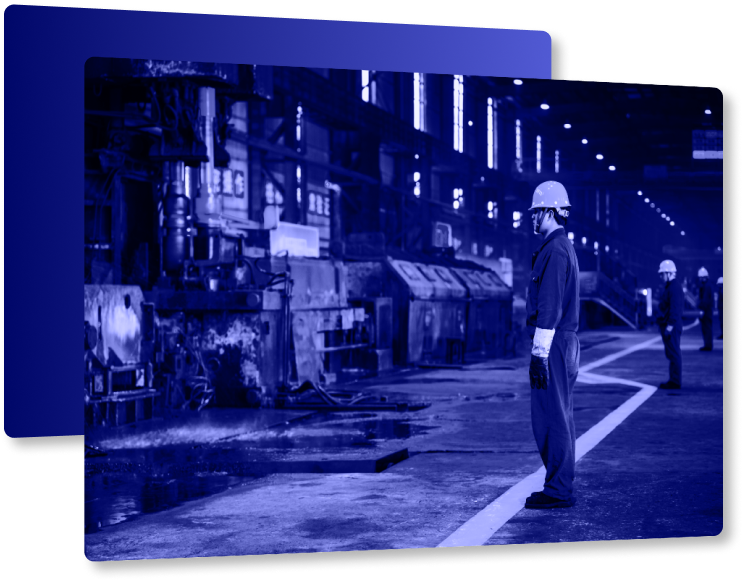Introduction
Workplaces consist of a large number of mobile and fixed machines. In case of a moment of forgetfulness, inattention and carelessness, these machines can cause very serious work accidents.
HSE.AI acts as a third eye in workplaces. It warns you against possible dangers, and ensures that the danger is reduced through remote intervention systems when necessary...
1. Overview of Workplace Threats
You cannot predict when and how the danger will occur, although you ensure the safety of moving and fixed machines, if there is a human factor, the probability of the occurrence of the danger is always high.
The aim here is to prevent risks related to human factor.
2. Mobile Threats in the Workplace
High-voltage cabinets, pressure vessels, natural gas systems, devices with the risk of flaming and explosion, containers filled with dangerous chemicals, barrels, can be given as examples of constant threat factors.
With HSE.AI, you can monitor approaches and interventions on these systems in a controlled manner without interruption.
2.2 Data Leakage and Privacy Risks
Workplaces often handle sensitive and confidential data, making it crucial to establish guidelines for data handling. Employees should be aware of the risks associated with data leakage and the importance of maintaining privacy. Implementing secure file sharing platforms and encrypted communication channels helps minimize privacy risks and ensures the confidentiality of sensitive information.
3. Fixed Threats in the Workplace
Fixed threats refer to security risks associated with the physical infrastructure and network systems within the workplace. Addressing these threats is vital to prevent unauthorized access and protect sensitive data from potential breaches.
3.2 Unauthorized Access and Physical Security
Unauthorized access to restricted areas or confidential information can lead to significant security breaches. Implementing access control systems, surveillance cameras, and visitor management protocols helps prevent unauthorized individuals from gaining entry. Additionally, promoting a culture of security awareness among employees fosters vigilance and reduces the risk of physical security breaches.
4. Chemical Hazards in the Workplace
Certain workplaces deal with hazardous chemicals that can pose risks to employee health if not handled properly. Implementing safety measures is crucial to minimize the potential harm caused by these chemical substances.
4.1 Identifying Chemical Hazards
Workplace assessments should be conducted to identify and classify hazardous chemicals. Material Safety Data Sheets (MSDS) provide essential information about the potential risks associated with specific chemicals. Understanding the hazards involved enables employers to implement appropriate safety measures.
4.2 Proper Storage and Handling of Chemicals
Safe storage and handling procedures are critical to prevent accidents and minimize exposure to hazardous substances. Chemicals should be stored in designated areas with proper labeling and adequate ventilation. Employers must
provide training to employees on safe handling practices and ensure the availability of appropriate personal protective equipment (PPE).
4.3 Personal Protective Equipment (PPE)
Employees working with or around hazardous chemicals must utilize suitable PPE. This may include gloves, goggles, respirators, and protective clothing. Regular maintenance and replacement of PPE should be enforced to ensure its effectiveness in protecting employees from chemical hazards.
5. Ensuring Safety and Security
Maintaining a safe and secure workplace requires a comprehensive approach that addresses both mobile and fixed threats, as well as chemical hazards. Here are some strategies to ensure safety and security:
5.1 Implementing Strong Security Policies
Establishing robust security policies and procedures is essential for protecting the workplace from potential threats. These policies should cover aspects such as acceptable use of mobile devices, network security protocols, and guidelines for handling hazardous chemicals.
6. Conclusion
Creating a safe and secure workplace involves addressing mobile, fixed, and chemical threats effectively. By implementing appropriate security measures, providing employee training and awareness, and conducting regular security audits, organizations can protect their employees and safeguard sensitive information.
Frequently Asked Questions (FAQ) - Workplace Safety and Security
What is HSE.AI and how does it enhance workplace safety?
HSE.AI is a system that acts as a safety in workplaces, warning against possible dangers and enabling remote interventions when necessary. It helps monitor and control risks associated with mobile and fixed machines, reducing the likelihood of accidents caused by human factors.
How can workplaces address privacy risks and data leakage?
Workplaces should establish guidelines for data handling, make employees aware of data leakage risks, and emphasize the importance of maintaining privacy. Using secure file sharing platforms and encrypted communication channels helps minimize privacy risks and ensures confidential information remains secure.
What are some strategies to prevent unauthorized access and physical security breaches?
To prevent unauthorized access, workplaces can implement access control systems, surveillance cameras, and visitor management protocols. Promoting a culture of security awareness among employees enhances vigilance and reduces the risk of physical security breaches.
How should hazardous chemicals be handled to ensure workplace safety?
To ensure safety when dealing with hazardous chemicals, workplaces should:
- Conduct assessments to identify and classify hazardous chemicals.
- Refer to Material Safety Data Sheets (MSDS) for information on potential risks.
- Implement proper storage procedures with labeling and ventilation.
- Provide training to employees on safe handling practices.
- Ensure the availability and proper use of personal protective equipment (PPE).
What are the key strategies for maintaining a safe and secure workplace?
To maintain a safe and secure workplace:
- Establish strong security policies covering mobile device use, network security, and chemical handling.
- Implement HSE.AI or similar systems to monitor and control machine-related risks.
- Conduct regular security audits to identify vulnerabilities.
- Promote security awareness among employees through training and education.
- Continuously update and adapt security measures based on technological advancements and emerging threats.
Remember, ensuring workplace safety and security is an ongoing effort that requires collaboration among employees, management, and technological solutions to mitigate risks effectively.


